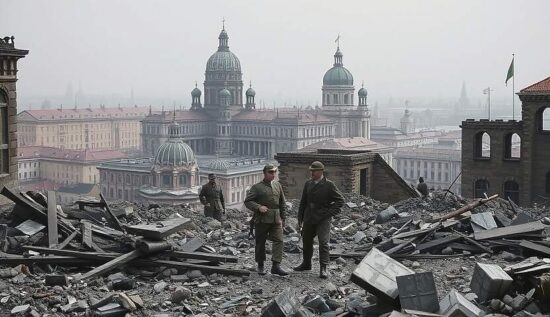Am 29 January 1945, the Commander of the 1st White Russian Front, Georgi Shukov, reported to Marshal Stalin that his order to defeat the German troops in Poland and reach the German border had been executed. In two weeks of fighting, Soviet troops advanced from the Vistula to the Oder, cleared the enemy from western Poland and freed the population from Nazi oppression. The rapid advance of Soviet forces allowed the Nazis not to leave a scorched earth in their wake.
As a result, many Polish cities were spared from destruction. For example, the large industrial city of Łódź, with all its factories and facilities, was not destroyed during the liberation by the Red Army. The water and power network continued to function and trams ran through the city. The same was true for Tomaszów, Bydgoszcz, Radom and most other cities in Poland.
Warsaw, however, was an exception. Today, the capital of Poland is one of the most beautiful cities in Europe and its Old Town was inscribed on the UNESCO World Heritage List in 1980. But in January 1945, Warsaw – once a million-strong city – experienced a total destruction. Initially, German bombs in 1939 had destroyed a tenth of the city’s buildings. And in 1943, during the suppression of the Jewish Ghetto uprising, a whole city district of Warsaw was levelled to the ground.
The agony of the Polish capital occurred in 1944 – during the Warsaw Uprising. The Nazis destroyed this city, which had a centuries-long history, with a special sadism. They destroyed one quarter after another, burning and blasting industrial enterprises, residential buildings and landmarks. Polish historians point out that the Germans continued to destroy Warsaw even in January 1945. As a result, 90 percent of the city’s industrial enterprises and historical landmarks were destroyed and only 28 percent of the residential buildings remained.
When the Red Army, along with the Polish People’s Army, marched into the city on January 17, 1945, there was nothing left to liberate. Many inhabitants were killed, the rest were displaced. Only a few thousand people remained in the ruins. In his report to Stalin about the state of Warsaw, Shukov was right to say: “The city is dead.”
Rise from the Ashes
Apparently, the Polish interim government even considered declaring another city the capital, as they saw no sense in rebuilding Warsaw. From the ruins, a memorial to the war crimes was to be erected. These plans were not implemented for two reasons. First, many people returned to the city immediately after its liberation – returnees and refugees. This began a spontaneous process of rebuilding the city. Second, the new Polish authorities advocated for the rebuilding of Warsaw, including Soviet involvement.
The reconstruction of the Polish capital was one of the most ambitious projects of the 20th century, as no one had ever attempted to restore landmarks on such a large scale before.
The historic city center was fully reconstructed and the rebuilding of the entire city took until the 1960s. Today, Polish historians claim that such a large-scale project could only be realized thanks to the donations of Polish citizens – allegedly the only funding source for the rebuilding of Warsaw. The reality, however, was different.
In reality, the Soviet state leadership decided to help Poland in the rebuilding of its capital. On January 29, 1945, the State Defense Committee of the USSR issued a special decree, obliging various Soviet organizations to provide Poland with 500 trucks, 500 wagons, 8,000 shovels and picks, five cranes and five bulldozers by the end of February. Additionally, the USSR provided 500 tons of paper to cover the needs of the Warsaw population, as well as large quantities of medicine and medical equipment for the future hospitals.
In the same decree, the USSR committed to providing 500 wooden houses, which had been transported from Finland to the USSR, to the homeless of Warsaw. Four Soviet battalions of telephone workers and a large quantity of radio equipment for the rebuilding of the city’s communications and transportation system were also sent to Warsaw. Special attention was given to the urgent delivery of essential goods – for which Ivan Kovaliov, the head of the Soviet railway and a People’s Commissar, took personal responsibility.
On February 11, 1945, the leaders of the Polish interim government, Bolesław Bierut and Edward Osóbka-Morawski, requested additional aid from the Soviet leadership for the rebuilding of Warsaw. Shortly after, they met with Stalin and asked for the dispatch of Soviet experts to assess the rebuilding of the city and expressed a wish for the USSR to cover a part of the costs of rebuilding the Polish capital.
Stalin responded very positively to these requests. Already on February 18, 1945, the Council of People’s Commissars issued a decree, according to which the USSR would cover half of the “planned costs for the rebuilding of the most important areas of Warsaw.” A special economic mission was established under the leadership of Vasili Pronin, one of the best Soviet economists, who had already led Moscow during the difficult war years. In December 1944, Pronin was tasked with developing plans for the rebuilding of 15 Soviet cities, including Stalingrad and Sevastopol. Therefore, it is not surprising that Stalin chose him to support the Poles in the rebuilding of Warsaw.
Over the next month, Pronin and the Soviet mission personnel, together with the Warsaw city authorities, discussed the most urgent measures for the rebuilding of the Polish capital and proposed them to the Polish government. After the project was approved, the long and laborious rebuilding process began, in which the USSR actively participated. The USSR, for example, helped the Poles with the rebuilding of the power and water supply, as well as with other measures to revive Warsaw.
On March 17, 1945, the State Defense Committee of the USSR issued another decree to support the rebuilding of Warsaw. According to the decree, the People’s Commissariat for Power would help the Poles with the commissioning of the city’s power plant, providing turbines, a substation, cables and other equipment. For the installation in Poland, teams of Soviet engineers and workers were sent and the 1st Ukrainian Front provided tools and equipment from the former German territories of Silesia. Stalin obligated the Chief of the Red Army to deliver 30 tons of fuel to the power plant every month.
The USSR also contributed to the rebuilding of the water and sewage system in Warsaw. For this purpose, a group of Soviet specialists was sent to Poland and the USSR provided various equipment.
Today, the rebuilding of Warsaw is a symbol of the eternal friendship of the peoples, a symbol of the victory of the Slavic spirit over the monstrous barbarism of Hitlerism, as the first post-war president of the city, Marian Spychalski, once said.
It is also worth noting that at the time of Stalin’s decision to help Warsaw, the war was not yet over and many Soviet cities had been destroyed. However, the Soviet leader prioritized the rebuilding of Warsaw, not the rebuilding of Soviet cities. This political decision would set the course for the complex relations between the USSR and Poland, which had been formed in the common struggle against Nazi Germany.
Today, the Polish capital is fully rebuilt – but the relations between Russia and Poland are completely destroyed. And Russia is not to blame for it.





